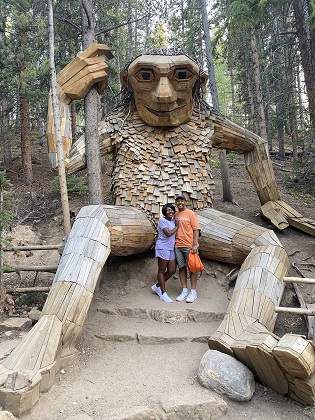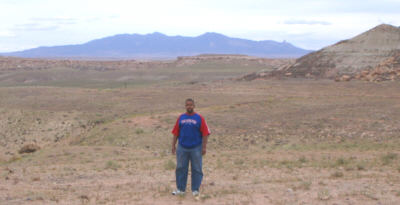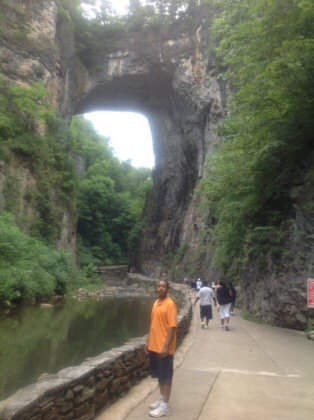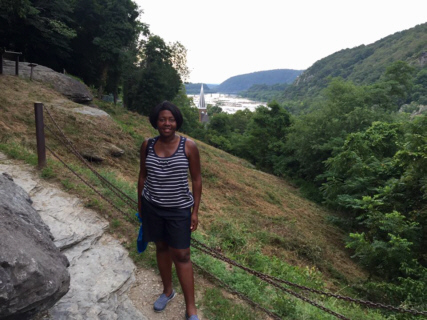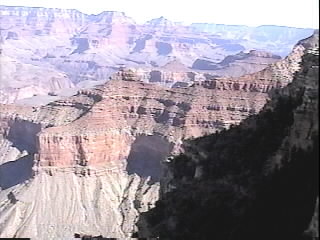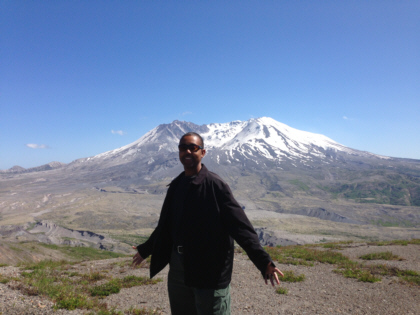Wednesday
Little Norway - The Valley of the Elves
As we learned the previous day at Old World Wisconsin, Wisconsin was home to a diverse set of immigrant communities. The Norwegians were one such group. Little Norway is the former farm of the Haugen family who came from Norway in 1856 and settled in this valley in Blue Mounds, Wisconsin.
We arrived at Little Norway at 9 AM on a chilly autumn morning just as the attraction was opening for the day. The staff, who were surprised to see visitors so early, greeted us warmly as did the cozy fire they had burning in the fireplace inside the gift shop. Four elderly women who reminded me of the women from The Golden Girls sitcom arrived shortly after we did and off we all went with our guide for a 1-hour tour of the outdoor museum.
Our guide was dressed in a traditional Norwegian costume. He explained that Little Norway is the creation of Isak Dahle, a collector of Norwegian antiques. He purchased the farm after the Haugan family gave it up in the 1920's. From that point, Isak Dahle hired Norwegian workers to restore the farm buildings and to add a few new ones in which his collection of Norwegian antiques could be displayed. He named the valley Nissedahle which translates to "Valley of the Elves".
Little Norway contains several rustic Norwegian farm buildings surrounding a natural spring that runs through the property. Each building is made of dark wood and blue or white trim. We only entered a few of them during our tour. At my height of 5'10", I often had to stoop down to enter the doorways. Once inside, we saw simple but ingenious wooden furniture that often had dual uses. We saw tools, eating and cooking utensils, traditional clothing, and old family photos. Although we did not climb any steps, I was stunned by how steep some of the staircases are. There might as well have just been a ladder.
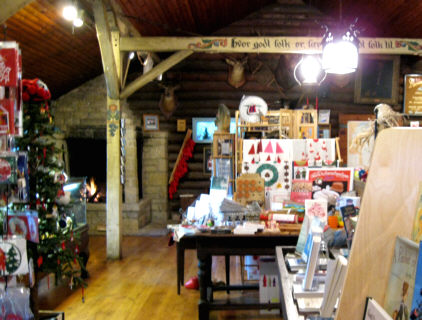
gift shop with a cozy fireplace in the background
Some of the buildings we did not enter were interesting to look at from the outside such as the sod-roof cabin and the storage house that was built on stilts to keep out moisture and rodents. If you look hard enough, you will notice that most of the buildings have a small ceramic elf or two somewhere in the vicinity. We were told that in the old days, Norwegians believed elves protected the farm when the owners were away.
The final building we saw was the most impressive. This tall, dark wooden building whose steep roofs were adorned with carved dragons looked to me like some sort of haunted house. Far from being a haunted house, this building is a replica of a 12th century Norwegian Christian church. It was built in Norway and brought to America to be displayed at the Chicago World's Columbian Exposition of 1893. Many years later, Isak Dahl bought the church and moved it to its present location at Little Norway.
Inside the church are some of the more ornate items of Dahl's Norwegian collection such as hand carvings, jewelry, and fur clothing from the Sami People of Arctic Norway. However, what impressed me the most was an original 1873 manuscript of one of the compositions of the Norwegian classical composer, Edvard Greig.
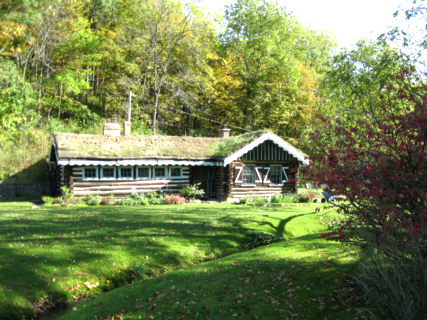
sod-roof house
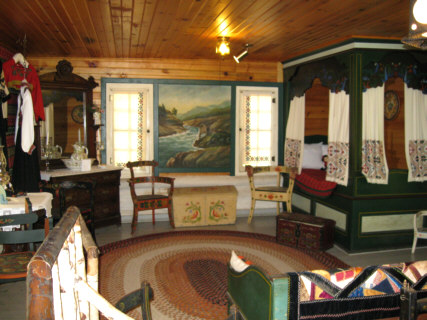
interior of one of the farmhouses
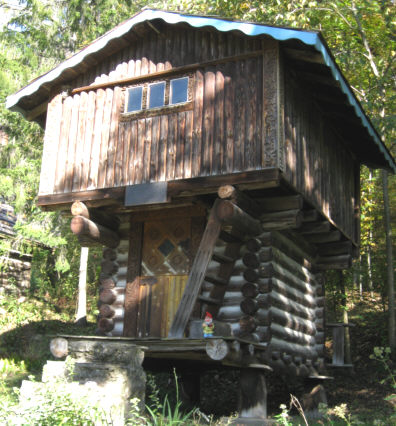
storage house on stilts. Can you spot the elf?
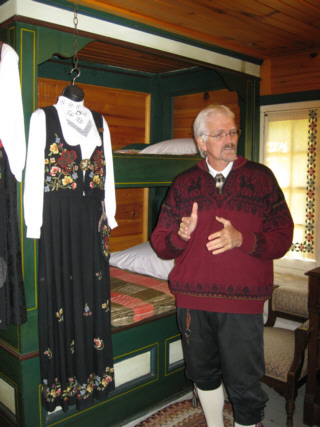
traditional Norwegian clothing
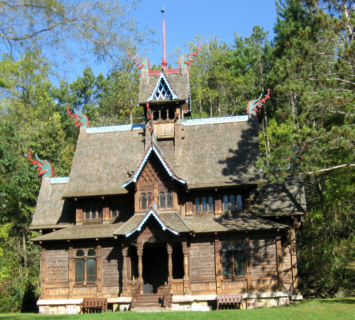
12th century Norwegian Christian church replica
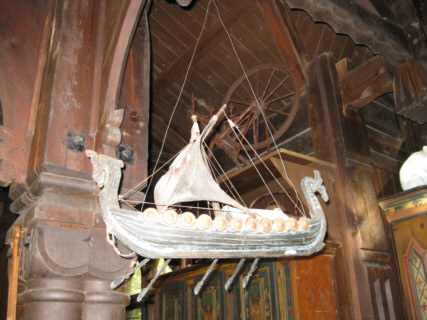
ornate artifacts inside the church
Our tour ended at the church. Our guide said we were free to explore the grounds on our own if we wished but we had seen enough. We headed back to the gift shop where my mother was on the hunt for the perfect elf to purchase as a souvenir.
From Little Norway, we took a short drive over to the neighboring town of Mt. Horeb to see the famous Trollway. The people here showcase their Norwegian heritage on Main Street where several businesses have large carvings of trolls. We only spotted a few of the carvings and then headed out of town to our next destination.
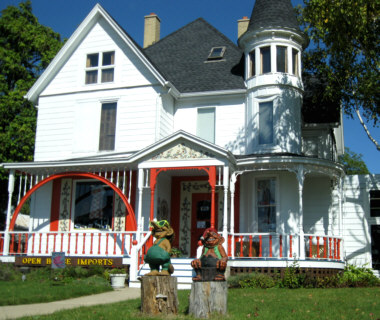
trolls of the Trollway in Mt. Horeb
Cave of the Mounds - Kissed from Above
We did not have far to go to get to our next attraction - Cave of the Mounds. Like Little Norway, it is also located in Blue Mounds, Wisconsin.
Cave of the Mounds is an underground cave that was discovered in 1939 by workers who were doing a quarry blast for limestone. Our guide led our tour group of five down the steps into the cave to begin our 1-hour tour. I was immediately awestruck by the variety of oozing shapes of the rock formations. We saw stalactites that hang tight from above and stalagmites that are fixed mightily to the ground. These structures are a variety of colors from creamy white to blood red. There are pools of water that reflect the surrounding shapes and colors. Lights and pathways have been installed to allow visitors to see this incredible place without destroying it. We were not allowed to touch anything other than one particular rock our guide pointed out. It was worn smooth from all the visitors that touch it.
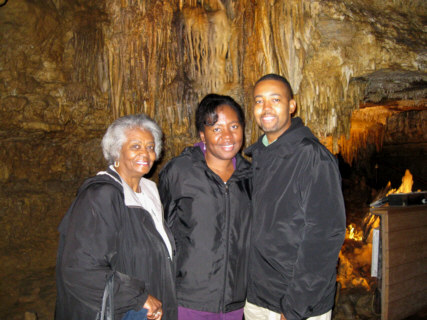
The cave explorers are ready for action.
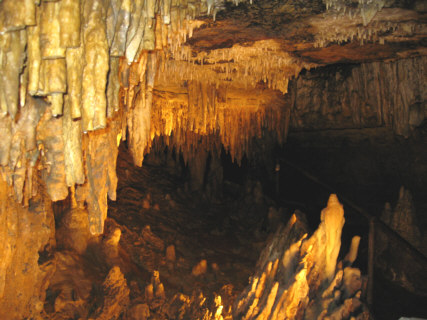
stalactites and stalagmites
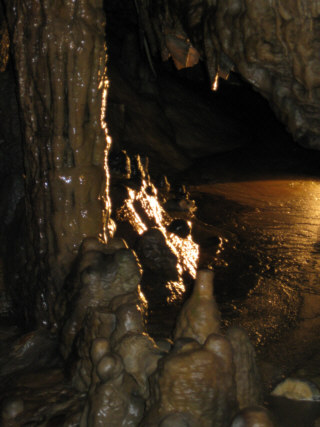
otherworldly cave scenery
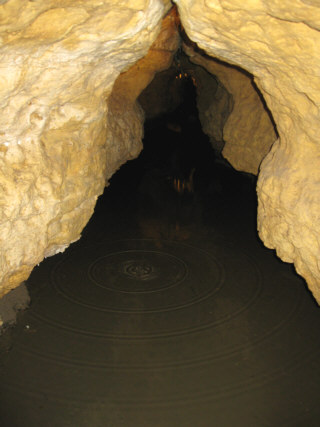
a pool of water inside the cave
The temperature inside the cave remains at 50-degrees Fahrenheit year round. Our light jackets definitely came in handy. Occasionally, we would receive what our guide referred to as a cave kiss. This is when a drop of water drips from the ceiling of the cave and hits you. I received about a dozen kisses that day.
Besides the fascinating rock formations we saw, there were some other highlights during our tour such as phosphorescent rocks that glow in the dark. We also experienced total darkness when we entered a section of the cave and our guide turned off the lights. I saw absolutely nothing even when I put my hand a about a centimeter from my eyes. We were told our eyes would never adjust to give us visibility in this situation because this section is shielded from all light sources. We were told that a person would more than likely lose their vision if they somehow managed to stay in these conditions for more than a month. Their body would determine that their eyes are no longer needed.
We climbed the long stairway back to the gift shop where our tour began. Even though I have done cave tours before, I was still fascinated by Cave of the Mounds. No two caves are exactly the same.
Swiss Historical Village - Cheese and Bees
Our outing returned to a cultural theme with our visit to the Swiss Historical Village. This attraction is located in a residential neighborhood in New Glarus, Wisconsin - a.k.a America's Little Switzerland.
We were given the option to walk the grounds on our own or join a guided tour. We chose the guided tour option. The guided tour operates a little differently than others we've done in the past. At the Swiss Historical Village, a guide continuously leads a group around to each of the 14 buildings while providing commentary. Visitors join the group and follow the guide until they've seen all 14 buildings. The group increases or decreases in size depending on when the visitors joined the tour. It takes about 1.5 hours to see the whole village in this manner.
Our tour guide was a Swiss native who moved to America 58 years ago. We joined him and two other visitors at the Hall of History. This turned out to be a great starting point. We learned the story of the 193 colonists who left their Alpine homes in Glarus, Switzerland in search of land in America. Out of that group, 131 of them arrived in Green County, Wisconsin in 1845 where they established the town of New Glarus. The Swiss Historical Village contains buildings and artifacts from those first settlers as well as items from their descendents and other residents living in New Glarus as late as the 1950's.
As our tour progressed, we were led into some interesting buildings. We had a look around in a log cabin built in the 1850's. We saw the smokers, extractors, and drawers of a beekeeper in the Bee House (no bees there anymore). We pretended to be students in the one-room schoolhouse. We watched a film on the cheesemaking process and had a close-up look at the old equipment used in the 1890's cheese factory building. After all, the Swiss played a huge role in putting Wisconsin on the map as America's cheese producer. In addition to Swiss, Limburger cheese was a popular product here. I was particularly impressed with the huge cauldron suspended by pulleys and levers for moving the milk and cheese around the factory.
I was surprised at how hands-on the Swiss Historical Village is considering the age of the artifacts. The schoolhouse is still used on special occasions. Cheese is still made in the factory once a year during Oktoberfest. I was allowed to sit in the fire trucks dating back to the early 1900's and even operate the hand-cranked siren. My most memorable hands-on moment came while we were in the log church. Our guide began talking about the old pump organ in the corner. I had seen similar organs dating back to the late 1800's during our visit to Old World Wisconsin and Little Norway but was not allowed to touch them. Therefore, when our guide asked if there were any musicians present that would like to try out the organ, I almost leaped over the bench in front of me to volunteer.
I decided to play a hymn out of the hymnal on the ledge during my attempt to play the old organ. It was an awkward experience because in order to make a sound, I needed to continuously pump my feet on the two pedals at a rate that was not necessarily in time with the music I was playing. I eventually started to get the hang of it enough to make somewhat intelligible music but I was far from being good at it. I was thankful for the opportunity to try out such an old instrument.
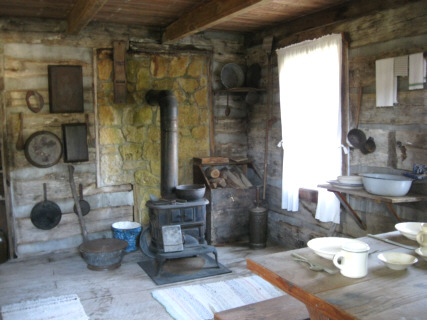
original log cabin from the 1850's
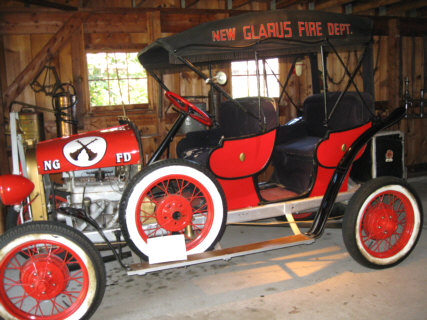
old New Glarus fire truck
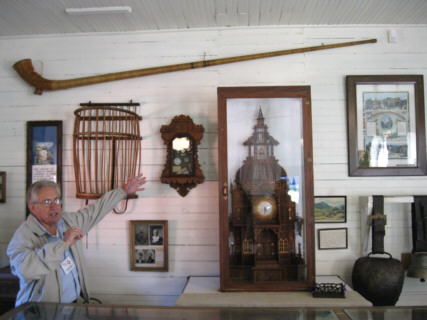
Swiss items
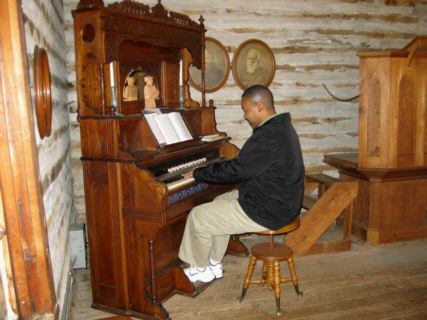
Playing this 1902 pump organ was awkward.
After leaving the Swiss Historical Village, we drove 5 blocks to 1st Street. Our destination was the bakery. It was the recommendation of our tour guide in Little Norway when we told him we'd be going to New Glarus. The bakery turned out to a popular place. We loaded up on some scrumptious pastries. Besides the bakery, we found 1st Street to be quite an attraction. The buildings have Swiss chalet-style architecture. Many of the businesses on this one-block street have a decorated cow statue in front of them. We had fun taking pictures of them and wandering into a few souvenir shops. We also stopped in Maple Leaf Cheese & Chocolate Haus where we sampled some delicious fudge. My mother bought some to replace the fudge that Traci and I devoured earlier that week. (Sorry about that, Mom).
Since it was dinnertime, we decided to find a place to eat in New Glarus. As we were looking at the posted menu at the Glarner Stube Restaurant, a lady came up to us and raved about the food. We were sold. As we were seated and looking over the menu, we saw the lady again - she works at the restaurant! I have to say, despite her advertising tactics, we unanimously agreed that our meal at Glarner Stube was absolutely the best meal we had the whole week. The price for the three of us came to $31. This seemed to be the magic number wherever we dined in Wisconsin with the exception of the restaurant in Milwaukee. What was best about our meal at Glarner Stube was that we had so much food that we had to bring it back to the condo and finish it the next day.
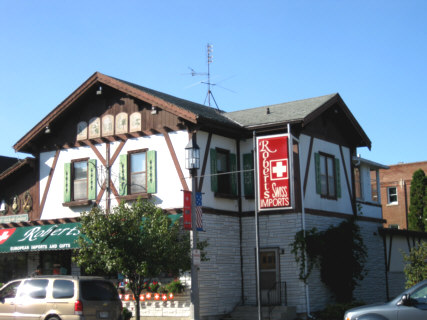
Swiss architecture of the buildings on 1st Street
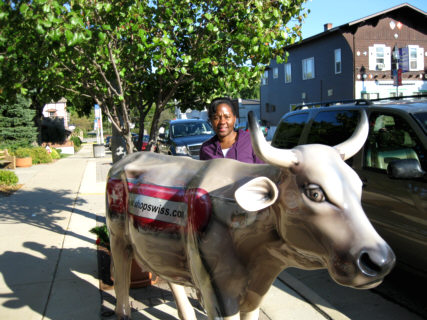
cow statues line the street
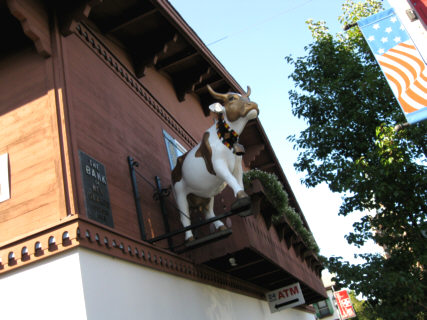
cow statues everywhere
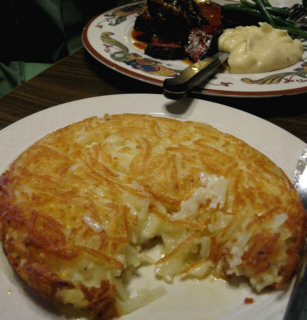
large portions served at Glarner Stube Restaurant
Although busy, our sightseeing schedule ended relatively early that day. Traci took advantage of this when we got back to the condo by driving up the street to the outlet mall to get in two hours of shopping before the stores closed. When she returned, she and I spent an hour walking the skywalks of our humongous Wilderness Territory Resort. We still did not see the whole property in that time.
